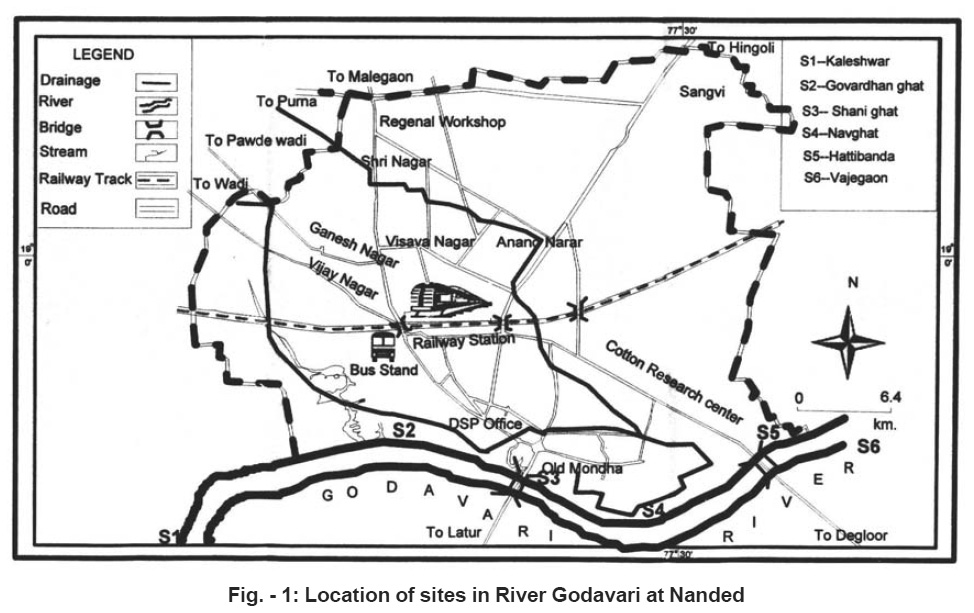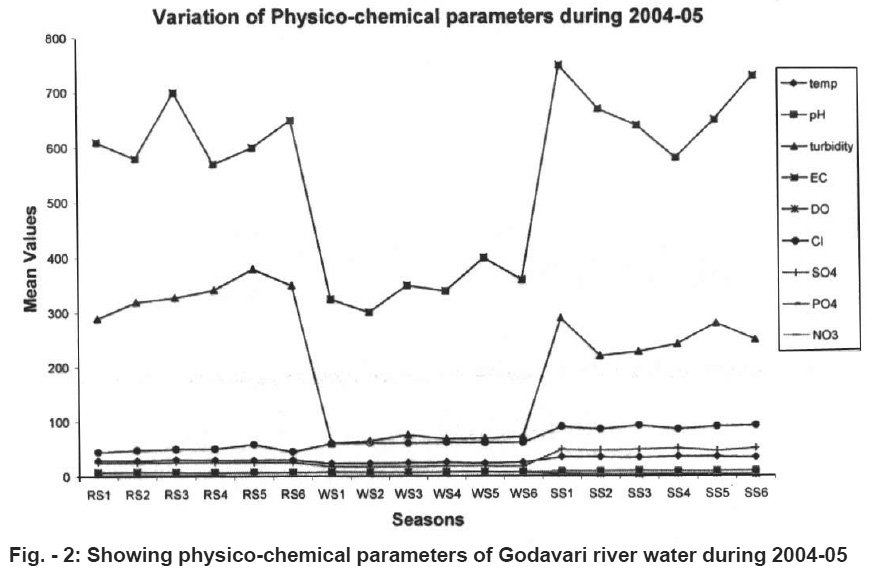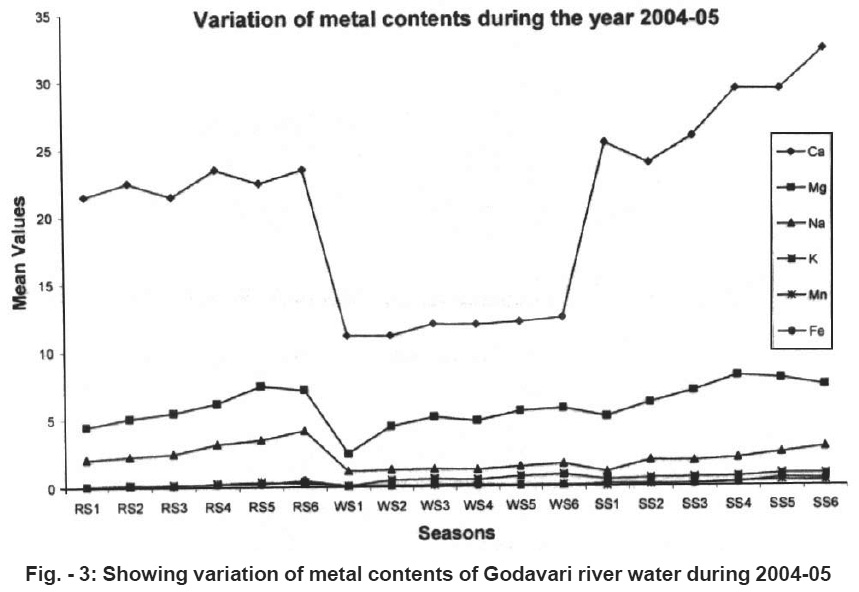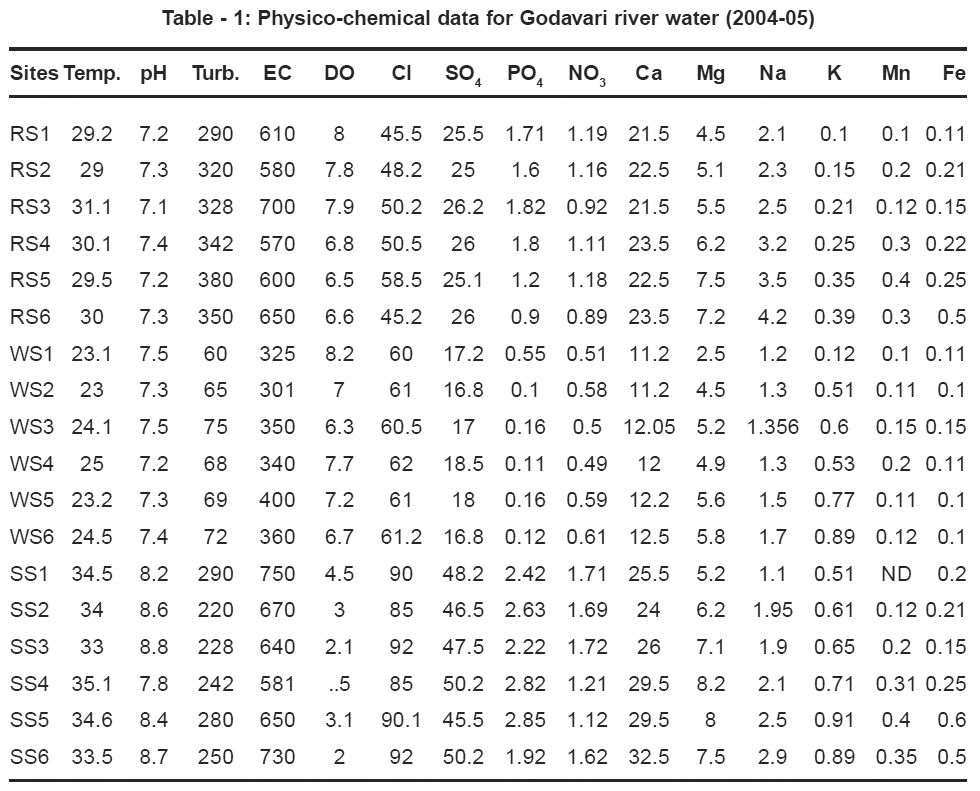Impact of city sewage discharge and anthropofenic activity on water quality at different ghats of river Godavari at Nanded, Maharashtra
A.S. Bansode1 * , N.M. Sontakke1 , D.R. Munde1 , S.B. Sirsat1 , M.M. Patthebahadur1 and Maya Raut 2 *
1
Department of Chemistry,
Science College,
Nanded,
India
2
Department of Zoology,
Science College,
Nanded,
India
DOI: http://dx.doi.org/10.12944/CWE.1.2.12
Huge city sewage discharge, waste and various anthropogenic activities put heavy pollutional load on river water. The rapid urbanization, hospital waste, waste from slaughter houses, small scale industries, various drains, nallas population explosion deteriorate the water quality of river Godavari. The pollution was monitored during rainy, winter and summer season with the help of physio-chemical parameters and trace metals analysis such as pH, temp, turbidity, conductance, DO, chloride, sulphate, phosphate, nitrate, Ca, Mg, Na, K, Mn, Fe. The present investigation reveals that the river water is polluted and need various remedial measures.
Copy the following to cite this article:
Bansode A.S, Sontakke N.M, Munde D.R, Sirsat S.B, Patthebahadur M.M, Raut M. Impact of city sewage discharge and anthropofenic activity on water quality at different ghats of river Godavari at Nanded, Maharashtra. Curr World Environ 2006;(1):165-168 DOI:http://dx.doi.org/10.12944/CWE.1.2.12
Copy the following to cite this URL:
Bansode A.S, Sontakke N.M, Munde D.R, Sirsat S.B, Patthebahadur M.M, Raut M. Impact of city sewage discharge and anthropofenic activity on water quality at different ghats of river Godavari at Nanded, Maharashtra. Curr World Environ 2006;(1):165-168. Available from: http://www.cwejournal.org?p=225/
Download article (pdf) Citation Manager Publish History
Select type of program for download
| Endnote EndNote format (Mac & Win) | |
| Reference Manager Ris format (Win only) | |
| Procite Ris format (Win only) | |
| Medlars Format | |
| RefWorks Format RefWorks format (Mac & Win) | |
| BibTex Format BibTex format (Mac & Win) |
Article Publishing History
| Received: | 2006-10-20 |
|---|---|
| Accepted: | 2006-11-30 |
Introduction
Water plays a vital role in living organisms in river water. The discharge of pollutants in river water is beyond limit and more than the self-purification capacity of river. Almost all rivers in India are affected due to pollution and reached a crisis point, and Godavari is not escaped from it. Origin of Godavari river is Bramhagiri at Trimbakeshwar in Nashik District of Maharashtra and the river flows through the central part or the Naded District from west to east further of down it enters Andhara Pradesh and finally into the bay of Bengal. The main tributaries of Godavari river are Sindaphana, Pruna, Manjra & Pranhita. The two major project, Jayakwadi near Paithan Vishnupuri at Nanded situated on the river Godavari. The main use of Vishnupuri projet is to supply water to the entire Naded city. Due to the rapid development, urbanization, population explosion Godavari river receives huge amount of untreated municipal waste and sewage at Nanded. Therefore it is essential to investigate the water quality and the effect of huge discharge of sewage along with various human activities at different sties of river Godavari.
Study Area
Site-I (Kaleshwar)
This site is situated at upper stream near Kaleshwar temple. The villagers washing, bathing and other activity are very frequent. Here we get the back water of Vishnupur dam.
Site-II (Govardhan Ghat)
This site is situtated at upper stream after kaleshwar where Godavari river enters into the city, Nanded. It is also known as burning ghat of Nanded city where huge amount of city sewage are discharged Washing, bathing, discharge of ash, hair cutting are frequent on this site.
 |
Figure - 1: Location of sites in River Godavari at Nanded Click kere to view figure |
Site-III (Shani Ghat)
The ghat is situated away form Govardhan ghat about 1.5 km downstream. Large number of people come from distant places for worshipping god “Shani” situated at this site. A huge nall acarrying city sewage and garbage meet the river at this point various human activities are freaquently practiced at this site.
 |
Figure - 2: Showing physico-chemical parameters of Godavari river water during 2004-05 Click kere to view figure |
Site-IV (Navghat)
This ghat is situated about 1km after shanty ghat towards down steam of Godavari river. Many human practices like fishing bathing, boating and recreation are frequent at this site. It has been used as a sink for dumping of domestic sewage and huge quantity of city garbage.
 |
Figure - 3: Showing variation of metal contents of Godavari river water during 2004-05 Click kere to view figure |
Site-V Hattibanda (Near Old Bridge)
This site is also known as Idgaha ghat this site is located 1.5 km away form Nav ghat towards down stream. Tow huge nalla with large quanity of city sewage and meet the river near this site along with run off from slaughters houses.
Site-VI(Vajegaon)
This site is situated near the villge Vajegaon towards downstream various activities of villager are frequent on this site.
Material and Methods
Water sample were collected from all the sites four times in each season at regular intervals. The samples were collected in a clean polythene can and for DO it was collected in BOD air tight bottle. Temp. pH, turbidity were measured in situ by using water analysis kit. Dissolved oxygen (DO) was determined by Winkler’s Methods. The other parameters were determined as per the standard methods (APHA 1995 and NEERI, 1988). K and Na were determined by Systronics Flame Photometer Burnner unit 121. Mn and Fe were measure by using. Atomic Absroption Sepctrophotometer.
 |
Table - 1: Physico-chemical data for Godavari river water (2004-05) Click kere to view table |
Results and Discussion
In present investigation the temp. Value fluctuates form 23.0 to 35.1°C. The maximum temperature recorded at different sites of Godavari river during summer might be due to high microbial activities and creation of anaerobic condition. The pH value river form 7.1 to 8.8. The pH gradual increasing during winter season and reached maximum during summer might be due to domestic sewage discharged and discharged in flow of river water. The maximum conductances were noted in summer 750 ms/cm while minimum in winter 301 ms/cm. The higher values of conductance in summer were due to increase in ionic species due to sewage and waste discharge. The maximum value of turbidity recorded weas 380 NTU in rainy season may be due to runoff water and minimum recorded was 60 NTU in winter season. The range of turbidity is higher in rainy season and might be due to various human activities. In summer the DO value was decreased up to 2.0 mg/L due to decease river flow and increase sewage discharge and might be due to various human activities at different ghats. In the present investigation the maximum concentration of chloride was recorded in summer due to decrease in flow of river water and high pollution load from city sewage and wastes and also surface run off during the each monsoon showers the conenctratrion of chloride decrease during monsoon due to increase in flow of river water. The concentration of phosphate might be increases due to discharge of untreated domestic wastes, hospital wastes, seweage form city drain and agriculture runoff. During summer and pre-monsoon phosphate concentration were higher. The nitrate contents in Godavari river water were observed higher in summer and pre monsoon season and lower in winter. The higher value might be due to various human activities city sewage waste agricultural runoff. The concentration of Calcium and Magnesium were higher in rainy season and summer which is responsible for the hardness of water. The trace metal concentrations were found to be more in summer due to restricted flow of river and huge pollutional load.
Comparing the observations with permissible limits prescribed by standard (WHO and ISI) it is noted that the water of Godavari river at all sites is not fit for drinking purpose. The results obtained indicate that Godavari river water was polluted at different sites and the pollution level enhances particularly in summer. The situation causes serious threat to public health and warrants stringent pollution control and measures in these sties of the river. It is essential to discharge the city sewage and municipal waste after proper treatment by the authorities and municipality.
References
- APHA,AWWA,WPCF, Standard method for examination of water and waste water 19th edition American Public Health Association, Washington, (DC). (1995).
- I.S.I Indian Standard Specification for drinking water, New Delhi (1983).
- NEERI Manual on water and wastewater analysis (1988).
- WHO. Geneva Guidelines for drinking water quality recommendation IInd Ed. ND (1993).







